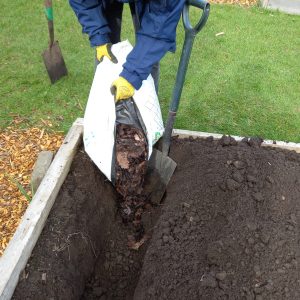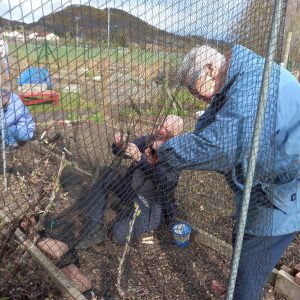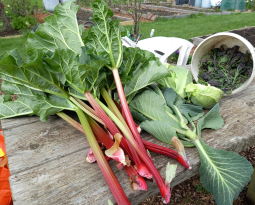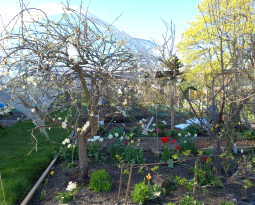The potatoes are in!
A decent morning, mild with patches of sun, though increasingly breezy. Luckily, we’d packed up before the afternoon showers came on.
Soil temperatures were up to 10 degrees centigrade – both under the polythene sheeting and the uncovered beds, so time to plant some early potatoes! Putting crops into the ground felt like a landmark event – the start of a year of growing!
We planted 4 early varieties; Sharpes Express; Colleen; Nadine and Acoustic (which can be grown as an early or main crop). These will give us a mix of floury and waxy potatoes. Trenches of a spade’s depth were dug and layers of leaf mould and manure added, before the tatties were nestled in, around 1Ft apart. Elsewhere, whilst digging over another bed, we found a rogue Pink Fir Apple potato – a favourite, which we were unable to find in seed form this year. We’re going to see if we can chit it for a token crop.
A team of weavers worked wonders on the fruit cage netting – quite a bit of patience required for this task.
There was also activity in the “unusual veg” bed. The climbing spinach is a healthy perennial green – a useful crop for early harvesting that can survive winter temperatures of -30 degrees. Young shoots can be harvested for fresh asparagus-like flavour. As it grows, it will wind itself round a wigwam and can be treated as standard spinach. We dug a trench around this and planted a partner plant– Hopniss (Apios Americana). This plant was cultivated by the indigenous people of The Americas and is a high protein member of the bean family. The tuber looks like a string of beads (see photo) and will likely take 2 years to establish. It is an adaptable plant that copes well with erratic conditions, so it will be interesting to see how it does in our increasingly unpredictable climate.
Manuring was another task today, with the fruit trees and bushes, rhubarb and strawberries all getting a treat. The sweet pea bed also got a mix of manure and leaf mould and as ever, we weeded.
More spears of purple sprouting broccoli and kale were harvested. These are proving delicious steamed lightly for a few minutes. We also found a few potatoes that missed the boat 3 years previously – still fine for human consumption.
Jobs for next week: spread ericaceous compost around the blueberries; concentrate weeding efforts in the back of the rhubarb bed, as alkanet is beginning to push through; possibly start harvesting rhubarb.
Recent Posts














